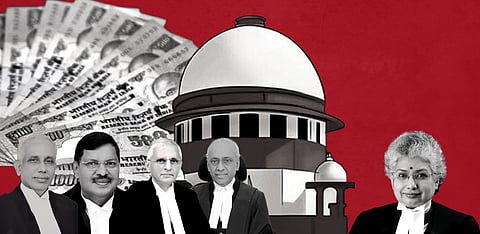

Both the majority and dissenting judgments are restricted to answering legal issues and fail to address genuine concerns of citizens.
—
EARLIER today, a Constitution Bench of the Supreme Court upheld the Union Government's demonetisation decision of November 8, 2016, by a majority of 4:1. Justices S. Abdul Nazeer, B.R. Gavai, A.S. Bopanna and V. Ramasubramanian signed off on the majority judgment, while Justice B.V. Nagarathna wrote a dissenting judgment.
The majority judgment, authored by Justice Gavai, found that the demonetisation decision was to eradicate black money and it had a reasonable nexus with the objectives it sought to achieve. It held that it does not matter whether the objectives have been achieved. Thus, the majority refrained from interfering in the economic policy of the country, and stated that it cannot supplant the wisdom of the executive with its own.
The bench reserved its judgment on December 7, 2022, after having heard arguments from both sides. On November 8, 2016, currency notes of Rs. 500 and Rs. 1,000 ceased to be legal tender through a Gazette of India notification.
It further held that a restrictive interpretation cannot be given to Section 26(2) of the Reserve Bank of India ('RBI') Act, 1934. The majority has purposively interpreted this provision to uphold that 'all series of 'any' denominations can be demonetised. It also held that the provision cannot be held unconstitutional merely because excessive delegation was made to the Union Government. There is an inbuilt safeguard because the Union Government remains answerable to its citizens through the Parliament, it held.
Justice Nagarathna dissented with the majority and held that a plain meaning has to be given to section 26(2) to mean that only a specific series of certain denominations can be demonetised.
Moreover, the RBI must exercise independent powers under section 26(2), as per her judgment. If a proposal for demonetisation is initiated at the behest of the Union Government and if the Central Board of Directors of the RBI concurs with it, the same is not akin to the requirement of original and independent recommendation of the RBI within the meaning of section 26(2), she opined.
She also held that the demonetisation notification does not clarify what occasion the Central Board of Directors of the RBI was consulted. Thus, according to her judgment, there was no independent application of mind by the RBI as the exercise was carried out in 24 hours and at the desire of the Union Government. The RBI may have given an opinion but an opinion does not amount to a recommendation within the procedure laid down under section 26(2).
Most importantly, demonetisation must be exercised through plenary legislation, as per Justice Nagarathna. She noted that the Parliament cannot be left aloof in such important economic decisions. The views of the Parliament are critical and of utmost importance. In this context, Justice Nagarathna found inherent contradictions in Section 3 of the Specified Bank Notes (Cessation of Liabilities) Act, 2017.
As a consequence, the 2016 demonetisation ordinance and the Specified Bank Notes (Cessation of Liabilities) Act, 2017, is unlawful and the demonetisation decision is rendered vitiated, as per her judgment. However, Justice Nagarathna clarified that the status quo ante could not be restored and thus she clarified that her ruling would operate prospectively.